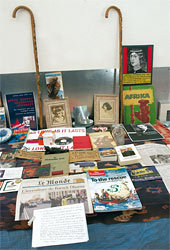Georges Adeagbo
dal 30/3/2009 al 12/9/2009
Segnalato da
30/3/2009
Georges Adeagbo
MAK Austrian Museum of Applied Arts / Contemporary Art, Wien
The Colonization and the History of the Colonized. The exhibition presents "archival" installations of the artist best known for his assemblages, in which he brings together different information carriers such as books, handwritten notes, photos, textiles, cult objects etc. arranging them into new narrative spaces. If Adeagbo incorporates sculptures in his work, which, from a European perspective, are labeled as tribal art or primitivism, the issue in fact is the re-conquering and repossession of previously colonized objects.

Curator Andreas Krištof
Georges Adéagbo, born 1942 in Cotonou, Benin, counts among the most
important artists of West Africa. In 1999, he took part in the 48th Venice
Biennale where he received the “Premio della giuria”, and in 2002, he was a
participant of the documenta 11 (under the curatorship of Okwui Enwezor).
2008, he was the first contemporary artist ever to make an intervention on the
premises of the Museo di Palazzo Vecchio in Florence.
From April 1, 2009, the MAK presents “archival” installations of the artist best
known for his assemblages, in which he brings together different information
carriers such as books, handwritten notes, photos, textiles, cult objects etc.
arranging them into new narrative spaces. If Adéagbo incorporates sculptures
in his work, which, from a European perspective, are labeled as “tribal art” or
“primitivism”, the issue in fact is the re-conquering and repossession of
previously “colonized” objects. His elaborate art-making process reaches out
across boundaries between epochs, continents, cultures, and genres, starting
out from the art of Africa and Oceania; the subjects that he addresses include
religions, war, socialism, slavery, art, and history, as well as the stories of mostly male—historical personalities.
For the MAK Gallery, Adéagbo is planning to cover the floor and walls with an
“assemblage-like” installation, visualizing the history of colonization and the
colonized in an arrangement of materials in rare density. Moreover, he will
reach out beyond his own exhibition by intervening directly in sections of the
MAK permanent exhibition which he will examine for colonial implications. In
the permanent exhibition Baroque Rococo Classicism (with an artistic
intervention by Donald Judd), for example, he will respond to a mid-18th
century cabinet, a present made by the town of Eger to Emperor Karl VI.
As a piece of so-called state furniture, it represents symbolically a claim to
hegemony over all continents, the meaning of which Adéagbo examines,
questions, and transforms in various different ways.
Adéagbo is well aware of the purposive character of the objects, but achieves
the necessary artistic transformation precisely by placing them in new
contexts, or unfolding new contexts, courageously altering history by re-telling
it in a different way. His working method is based on combining objects made
for him in Benin and others which he finds at or around the exhibition site and
incorporates in his work; the pieces thus created always define a concrete
frame of reference.
Georges Adéagbo was born as the oldest of eleven children in Cotonou, the
largest city of Benin in West Africa. Against the wishes of his family, he went
to study law in Abidjan, Côte D’Ivoire, and in Rouen, France. After the death of
his father, his family urged him to return to Benin in 1971 where he lived in
impoverished conditions. From this time until 1993, he created a large number
of assemblages in his house, which happened to come to the attention of a
French curator. Many important exhibitions followed: “Big City: Artists from
Africa”, Serpentine Gallery, London, 1995; “La mort et la résurrection”, Galerie
Nathalie Obadia, Paris, 1997; Johannesburg Biennale, Johannesburg, 1997;
“Roteiros. Roteiros. Roteiros ...”, São Paulo Biennal, São Paulo, 1998;
“Kunstwelten im Dialog”, Museum Ludwig, Cologne, 1999; Biennale di
Venezia, Venedig, 1999 (“Premio della giuria” for “The Story of the Lion”);
“Abraham – the Friend of God”, P.S.1, New York, 2000; “Das Pythagoreische
Zeitalter”, Galerie im Taxispalais, Innsbruck, 2001; documenta 11, Kassel,
2002; “Le théâtre du monde..!”, Museum Ludwig, Cologne, 2004; “Abraham,
l’ami de Dieu. Philadelphia version”, Philadelphia Museum of Art, Philadelphia,
2006; “Tout de Moi à Tous”, DAAD Gallery, Berlin, 2007; “La rencontre..!
Venise–Florence”, Museo di Palazzo Vecchio, Florenz, 2008.
MAK Press Office
Olivia Harrer, phone (+43 1) 71136229 fax (+43 1) 71136227 E-Mail presse@MAK.at
Press Preview Tuesday, March 31, 2009, 10.30 a.m.
Opening Tuesday, March 31, 2009, 8.00 p.m.
Peter Noever Director MAK
Andreas Krištof Curator MAK
and the artist will be present
MAK Gallery
Stubenring 5, 1010 Vienna
Tue MAK NITE© 10.00 a.m.–12.00 p.m.
Opening Hours Wed–Sun 10.00 a.m.–6.00 p.m., Mon closed
Admission € 9.90 with MAK Guide / € 7.90 / reduced € 5.50
Free Admission on Saturdays©



